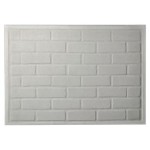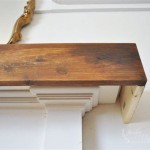Heat Resistant Spray Paint for Fireplace Doors
Fireplace doors serve both functional and aesthetic purposes. They prevent sparks and embers from escaping the fireplace, enhancing safety, and simultaneously contribute to the overall decor of the living space. Over time, the high temperatures generated by a fire can degrade the paint on these doors. Standard paint is not designed to withstand such intense heat and will often blister, peel, or discolor, diminishing the appearance and potentially compromising the protective qualities of the finish. Heat-resistant spray paint is specifically formulated to address this issue, offering a durable and attractive solution for maintaining the integrity and appearance of fireplace doors.
The selection of appropriate heat-resistant spray paint is crucial for a successful and long-lasting application. Understanding the different types of heat-resistant paints available, the preparation required before application, and the proper application techniques are essential for achieving optimal results. This article aims to provide a comprehensive overview of heat-resistant spray paint for fireplace doors, covering key considerations for selection, preparation, application, and maintenance.
Understanding Heat-Resistant Paint Composition
Heat-resistant paints differ significantly from conventional paints in their chemical composition. They are formulated with specialized resins and pigments that are capable of withstanding high temperatures without breaking down. These paints often contain silicone resins, which exhibit excellent thermal stability and flexibility, allowing the paint film to expand and contract with temperature fluctuations without cracking or peeling. Other common components include ceramic pigments, which offer exceptional heat resistance and color stability even at elevated temperatures.
The specific heat resistance of a paint is typically indicated on the product label, expressed in degrees Fahrenheit or Celsius. It is imperative to select a paint that is rated for temperatures exceeding the maximum heat output of the fireplace. For fireplace doors, paints rated for at least 1200°F (650°C) are generally recommended to ensure adequate protection and longevity. Lower-rated paints may be suitable for decorative elements further away from the heat source but are not appropriate for the doors themselves.
Furthermore, the coating type influences the overall performance. Some heat-resistant paints are designed for short-term, intermittent high-temperature exposure, while others are formulated for continuous high-temperature environments. Fireplace doors typically fall into the latter category, requiring a paint that can withstand prolonged exposure to high heat without degradation. Selecting the correct type is crucial for the paint's durability and functionality.
In addition to heat resistance, heat-resistant paints often offer enhanced corrosion protection. The high temperatures and combustion byproducts present in a fireplace can accelerate corrosion of metal surfaces. Heat-resistant paints containing corrosion inhibitors help to protect the fireplace doors from rust and other forms of degradation, extending their lifespan.
Preparing Fireplace Doors for Painting
Proper preparation of the fireplace doors is essential for ensuring optimal adhesion and a durable finish. Neglecting this step can result in premature paint failure, even with the highest-quality heat-resistant paint. The preparation process typically involves several key steps, including cleaning, removing rust, and priming.
The first step is to thoroughly clean the fireplace doors to remove any dirt, grease, soot, or other contaminants. A degreasing cleaner is recommended for removing grease and oil, while a wire brush or abrasive pad can be used to remove stubborn dirt and soot. It is important to rinse the doors thoroughly with clean water and allow them to dry completely before proceeding to the next step.
Rust, if present, must be removed before painting. Rust can prevent the paint from adhering properly and can also continue to corrode the metal beneath the paint film. Several methods can be used to remove rust, including wire brushing, sanding, and chemical rust removers. When using chemical rust removers, it is important to follow the manufacturer's instructions carefully and to wear appropriate personal protective equipment, such as gloves and eye protection.
Once the doors are clean and free of rust, priming is recommended to improve paint adhesion and provide a uniform surface for painting. A heat-resistant primer specifically designed for use with heat-resistant paints should be used. The primer should be applied in thin, even coats, following the manufacturer's instructions. Allow the primer to dry completely before applying the topcoat of heat-resistant paint. Proper priming is crucial for preventing peeling and ensuring a long-lasting finish.
Sanding the surface after priming can further enhance adhesion and create a smoother finish. Use a fine-grit sandpaper to lightly sand the primed surface before applying the heat-resistant paint. This step removes any imperfections and creates a slightly roughened surface that promotes better adhesion.
Application Techniques for Heat-Resistant Spray Paint
Applying heat-resistant spray paint requires careful technique to achieve a smooth, even, and durable finish. The application process should be carried out in a well-ventilated area, away from direct sunlight and excessive humidity. Wearing appropriate personal protective equipment, such as a respirator and gloves, is essential to protect against inhalation of paint fumes and skin contact.
Before beginning the painting process, shake the can of heat-resistant spray paint vigorously for at least two minutes to ensure that the pigments and resins are properly mixed. This will help to prevent uneven color distribution and ensure a consistent finish. Perform a test spray on a piece of scrap metal or cardboard to check the spray pattern and adjust the nozzle as needed.
Apply the paint in thin, even coats, holding the spray can approximately 10-12 inches from the surface of the fireplace doors. Overlapping each pass slightly will help to prevent streaks and ensure uniform coverage. Avoid applying the paint too thickly, as this can lead to runs, drips, and uneven drying. Multiple thin coats are generally preferable to a single thick coat.
Allow each coat of paint to dry completely before applying the next coat. The drying time will vary depending on the specific paint and the environmental conditions, such as temperature and humidity. Refer to the manufacturer's instructions for recommended drying times. Rushing the drying process can result in a soft, easily damaged finish.
For optimal durability, it may be necessary to cure the paint after application. Curing involves heating the painted surface to a specific temperature for a specific period of time. This process helps to cross-link the paint molecules, creating a harder and more heat-resistant finish. Follow the manufacturer's instructions for recommended curing procedures. In some cases, curing can be accomplished by gradually increasing the temperature of the fireplace following painting.
Clean the spray nozzle immediately after use to prevent clogging. Turn the can upside down and spray until only propellant is released. This will clear the nozzle of any remaining paint and ensure that the can is ready for future use.
After the final coat has dried and cured, inspect the painted surface for any imperfections, such as runs, drips, or uneven coverage. Minor imperfections can be corrected by lightly sanding the affected area and applying a touch-up coat of paint. Major imperfections may require stripping the paint and reapplying it from scratch.
By following proper application techniques and adhering to the manufacturer's instructions, one can achieve a durable, attractive, and long-lasting finish on fireplace doors using heat-resistant spray paint. This process not only enhances the aesthetic appeal of the fireplace but also protects the doors from the damaging effects of high temperatures and combustion byproducts.

Fireplace Door Update With Spray Paint Roots Wings Furniture Llc

How To Update Brass Fireplace Doors For Under 10 Everyday Old House

Use Fireplace Paint To Update Old Hardware For A Makeover

High Temperature Stove Spray Paint Charcoal Color

How To Paint Metal Fireplace Surround Four Generations One Roof

How To Spray Paint A Brass Fireplace Insert Erfly House

How To Spray Paint A Brass Fireplace Insert Erfly House

Fireplace Makeover With High Heat Spray Paint

How To Update Brass Fireplace Doors For Under 10 Everyday Old House

Fireplace Door Update With Spray Paint Roots Wings Furniture Llc








